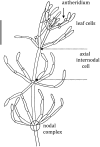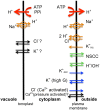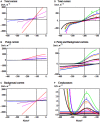Salt tolerance at single cell level in giant-celled Characeae
- PMID: 25972875
- PMCID: PMC4412000
- DOI: 10.3389/fpls.2015.00226
Salt tolerance at single cell level in giant-celled Characeae
Abstract
Characean plants provide an excellent experimental system for electrophysiology and physiology due to: (i) very large cell size, (ii) position on phylogenetic tree near the origin of land plants and (iii) continuous spectrum from very salt sensitive to very salt tolerant species. A range of experimental techniques is described, some unique to characean plants. Application of these methods provided electrical characteristics of membrane transporters, which dominate the membrane conductance under different outside conditions. With this considerable background knowledge the electrophysiology of salt sensitive and salt tolerant genera can be compared under salt and/or osmotic stress. Both salt tolerant and salt sensitive Characeae show a rise in membrane conductance and simultaneous increase in Na(+) influx upon exposure to saline medium. Salt tolerant Chara longifolia and Lamprothamnium sp. exhibit proton pump stimulation upon both turgor decrease and salinity increase, allowing the membrane PD to remain negative. The turgor is regulated through the inward K(+) rectifier and 2H(+)/Cl(-) symporter. Lamprothamnium plants can survive in hypersaline media up to twice seawater strength and withstand large sudden changes in salinity. Salt sensitive C. australis succumbs to 50-100 mM NaCl in few days. Cells exhibit no pump stimulation upon turgor decrease and at best transient pump stimulation upon salinity increase. Turgor is not regulated. The membrane PD exhibits characteristic noise upon exposure to salinity. Depolarization of membrane PD to excitation threshold sets off trains of action potentials, leading to further loses of K(+) and Cl(-). In final stages of salt damage the H(+)/OH(-) channels are thought to become the dominant transporter, dissipating the proton gradient and bringing the cell PD close to 0. The differences in transporter electrophysiology and their synergy under osmotic and/or saline stress in salt sensitive and salt tolerant characean cells are discussed in detail.
Keywords: Characeae; H+/OH- channels; action potentials; current-voltage characteristics; electrophysiology; non-selective cation channels; proton pump; salt tolerance.
Figures









Similar articles
-
Mechanosensory ion channels in charophyte cells: the response to touch and salinity stress.Eur Biophys J. 2002 Sep;31(5):341-55. doi: 10.1007/s00249-002-0222-6. Epub 2002 Jun 13. Eur Biophys J. 2002. PMID: 12202910 Review.
-
Modeling the Action Potential in Characeae Nitellopsis obtusa: Effect of Saline Stress.Front Plant Sci. 2019 Feb 18;10:82. doi: 10.3389/fpls.2019.00082. eCollection 2019. Front Plant Sci. 2019. PMID: 30833949 Free PMC article.
-
Salinity-induced noise in membrane potential of Characeae Chara australis: effect of exogenous melatonin.J Membr Biol. 2015 Feb;248(1):93-102. doi: 10.1007/s00232-014-9746-9. Epub 2014 Nov 7. J Membr Biol. 2015. PMID: 25378124
-
Surface pH changes suggest a role for H+/OH- channels in salinity response of Chara australis.Protoplasma. 2018 May;255(3):851-862. doi: 10.1007/s00709-017-1191-z. Epub 2017 Dec 15. Protoplasma. 2018. PMID: 29247277 Free PMC article.
-
Electrophysiology of turgor regulation in marine siphonous green algae.J Membr Biol. 2006 May;211(1):1-14. doi: 10.1007/s00232-006-0860-1. Epub 2006 Aug 14. J Membr Biol. 2006. PMID: 16909336 Review.
Cited by
-
Multi-Scale Characean Experimental System: From Electrophysiology of Membrane Transporters to Cell-to-Cell Connectivity, Cytoplasmic Streaming and Auxin Metabolism.Front Plant Sci. 2016 Jul 25;7:1052. doi: 10.3389/fpls.2016.01052. eCollection 2016. Front Plant Sci. 2016. PMID: 27504112 Free PMC article. Review.
-
How Plants Tolerate Salt Stress.Curr Issues Mol Biol. 2023 Jul 15;45(7):5914-5934. doi: 10.3390/cimb45070374. Curr Issues Mol Biol. 2023. PMID: 37504290 Free PMC article. Review.
-
The cell biology of charophytes: Exploring the past and models for the future.Plant Physiol. 2022 Oct 27;190(3):1588-1608. doi: 10.1093/plphys/kiac390. Plant Physiol. 2022. PMID: 35993883 Free PMC article.
-
Applied potassium negates osmotic stress impacts on plant physiological processes: a meta-analysis.Hortic Res. 2024 Nov 18;12(2):uhae318. doi: 10.1093/hr/uhae318. eCollection 2025 Feb. Hortic Res. 2024. PMID: 39949879 Free PMC article.
-
Allelopathic effects of Chara species (C. aspera, C. baltica, and C. canescens) on the bloom-forming picocyanobacterium Synechococcus sp.Environ Sci Pollut Res Int. 2018 Dec;25(36):36403-36411. doi: 10.1007/s11356-018-3579-5. Epub 2018 Oct 28. Environ Sci Pollut Res Int. 2018. PMID: 30368710
References
-
- Al Khazaaly S., Beilby M. J. (2007). Modeling ion transporters at the time of hypertonic regulation Lamprothamnium succinctum (Characeae, Charophyceae). Charophytes 1 28–47.
Publication types
LinkOut - more resources
Full Text Sources
Other Literature Sources

